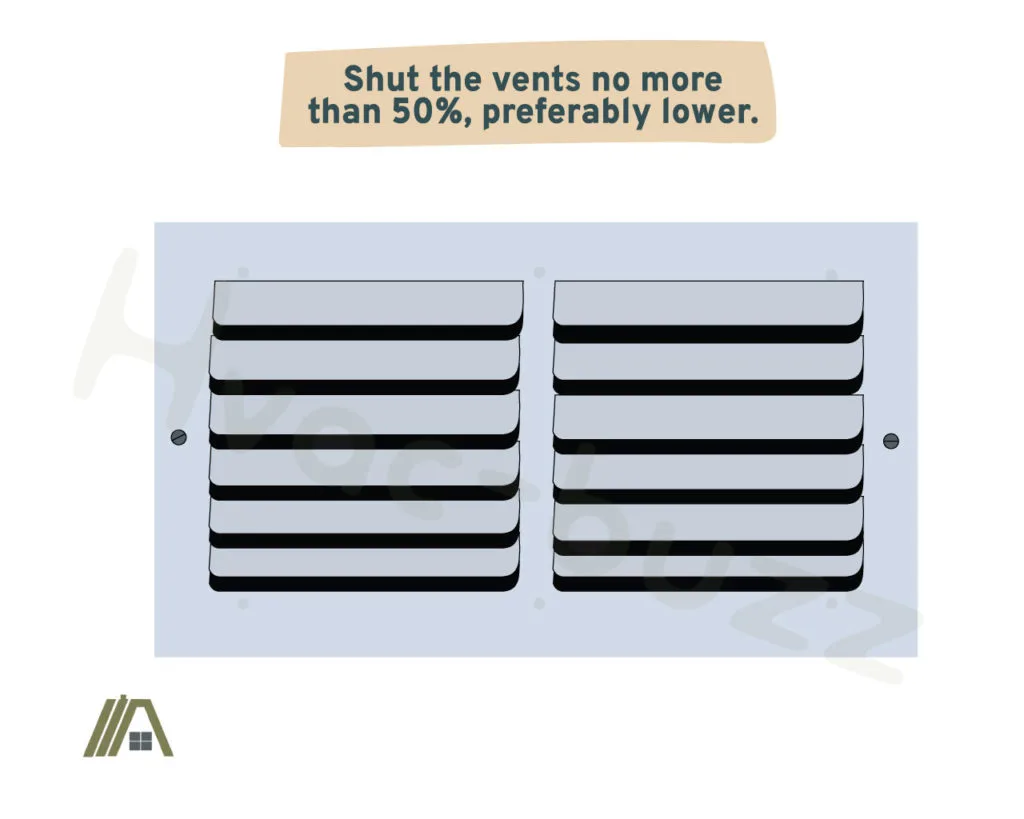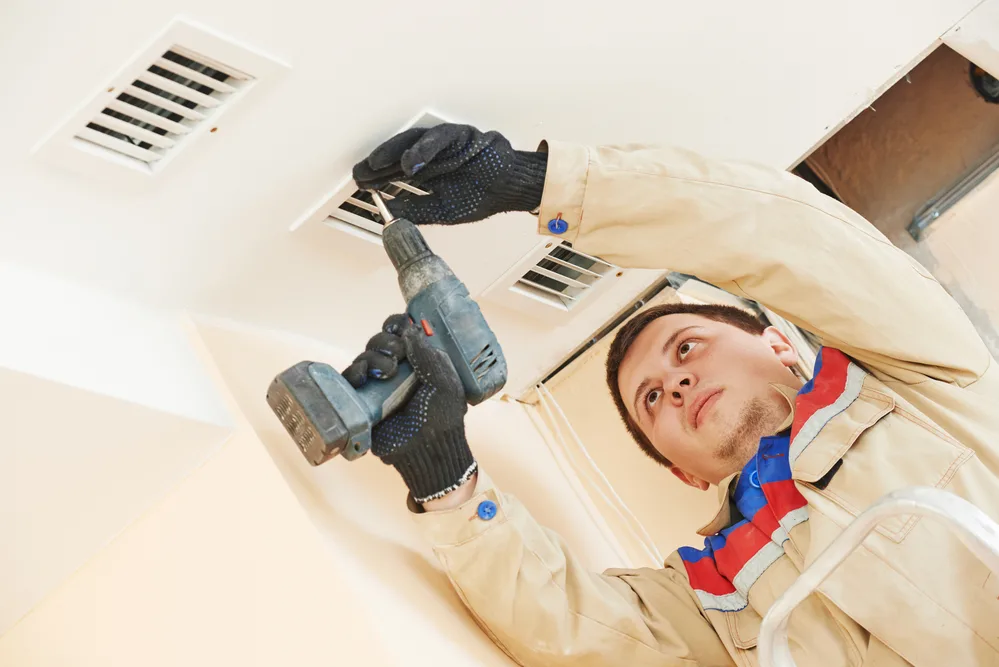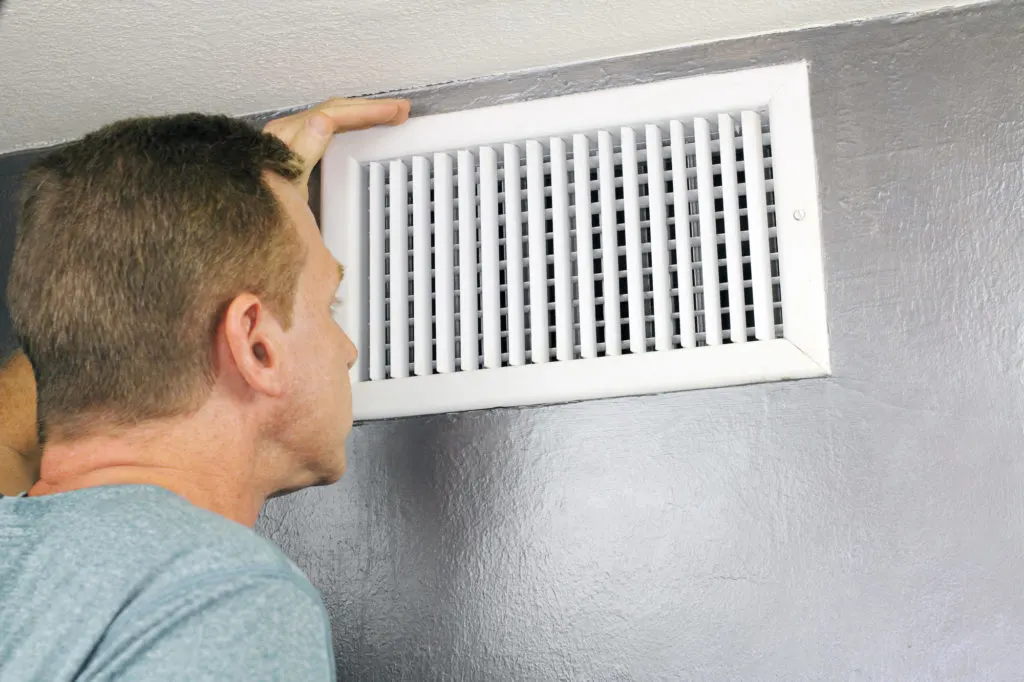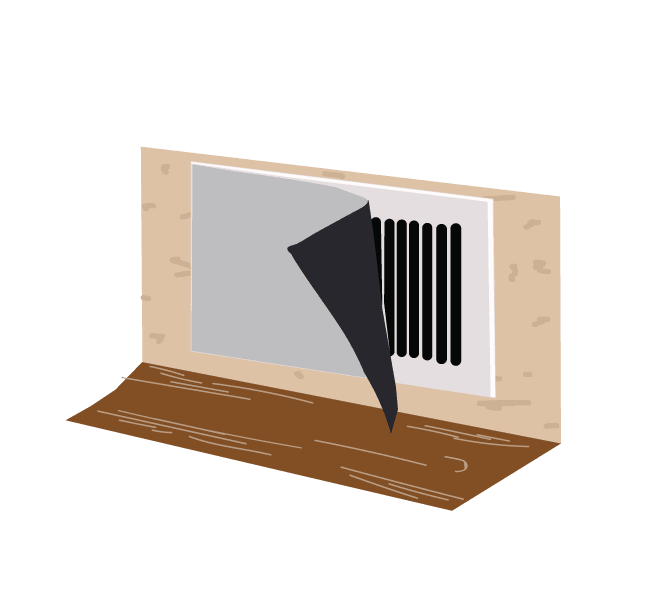While completely closing vents is generally frowned upon by HVAC professionals, partially closing supply air vents has received mixed reactions from experts. Some believe it is a safe way to control the temperature in your house. Others state that a lack of knowledge or professional experience makes this practice damaging to HVAC systems when attempted by homeowners.
Here is a detailed guide to help you navigate the process of partially closing your AC vents and safe alternatives that can help you control the temperature in your home and ultimately reduce energy consumption.

Partially closing AC vents is better than sealing them. Only close them up to 50%. Target ground floor vents and those furthest from the central unit. Only partially close a few vents. Only adjust them when required. Partially closed vents may not work as well as desired. Rather install a zoning system.
Idea Behind Partially Closing AC Vents
A popular myth among homeowners is that closing supply vents can reduce energy consumption. However, that’s a misconception that can eventually damage your HVAC system.
All HVAC systems are installed with careful consideration to the number of vents needed for effective air circulation. Thus, by messing with the established pattern of airflow, you increase the static pressure in your system.
An increased pressure level causes your system to work extra hard to make up for the sealed registers and this would eventually make your system slow down, lose its efficiency, and even fail entirely.
Partially closing AC vents is a middle ground between the problems caused by completely closing air vents and healthy indoor air quality.
Unlike when a vent is completely shut, partially closed vents allow air to still flow freely through the vents. That’s why it is recommended that you only shut vents between 50%-70%.
Most professionals would even advise that you shut the vents no more than 50%, preferably lower. This way, the slight change in air movement wouldn’t increase the static pressure within the unit, but it will still give you a bit more control over the temperature in a room conditioned by a central unit.

By partially closing the outlets farthest away from the central unit, you could even increase your energy savings.
Things to Consider
Many HVAC specialists that are against fully closing vents agree that partially closing registers might be effective if proper precautions are taken.

Margin for Error Likely to Be Small
I stated earlier that vents should be closed no more than 50-70%. However, closing the vents to the approved level could be tricky because you have no way of measuring how far you have shut the register. Thus, some homeowners could go overboard and unwittingly cause damage to the HVAC system.
The key requirement for a partially closed vent to yield the desired result is to close the vent such that the register continues to freely supply conditioned air.
If it is shut more than it should, air will back up into the ductwork, resulting in an increase in internal pressure.
For people without HVAC knowledge or experience, the process of partially closing vents would be a hit-or-miss procedure. That’s why it’s best to consult an HVAC specialist if you decide to partially close multiple vents in your home.
Signs That You Have Gone Too Far
If your vents are closed more than they should, your partially sealed vents would restrict the free passage of air and might harm your HVAC system the same way a completely closed vent would.
Should you partially shut vents more than 50%, especially if you close multiple vents, the airflow in your system might become restricted. If the airflow is restricted for a prolonged period, your air conditioning coils will freeze.
When this happens, the efficiency of your system will be affected. Here are some signs that your vents are closed tighter than they should.
- Your system would produce humming sounds.
- It would take longer to cool your home. It might even stop producing cool air altogether.
- Warm spots around the house.
- Water leaks.
Target Vents on Ground Floor
The natural way air moves around your home influences the operations of your HVAC system. Cold air is heavier and tends to fall while hot air rises. This is one of the reasons upper regions of houses are considerably warmer than underfloor areas like the basement.
As a result, it’s recommended that you partially shut the vents on the ground floor alone. That way, the natural order is preserved, and air circulation would allow the chill from upstairs to settle downstairs, resulting in an almost even indoor temperature.
If your system features top and bottom return vents, leave the top vent open and partially close the bottom vent in the summer months so that the system would draw air from the upper regions as cold air falls.
Only Partially Close a Few Vents
You might be tempted to partially shut all the vents in your house since a partially closed vent isn’t likely to affect the functionality of your HVAC system. However, you mustn’t partially seal multiple vents in your house at once.
For instance, if you have 10 supply vents in your home and you close six of them 60%, the effect this would have on your system would be the same as if you completely closed four vents.
Thus, it’s best to exercise caution while partially shutting vents. If you aren’t sure about how to go about the entire process, you can consult an HVAC specialist.
The point is to have a safe balance between return and supply airflow. This way your air conditioner wouldn’t suffer the dangers caused by ineffective airflow.
May Not Help Other Rooms Cool Faster
Another misconception many homeowners have is that they can redirect conditioned air by closing supply vents.
Your air conditioner can only produce a particular amount of air at a time. How much air it produces would depend on factors like the quality and specifications of the system.
By shutting or partially shutting vents, you don’t increase the amount of air available to get to some rooms; you just make it harder for the same air to reach its destination. Rooms with unsealed vents would naturally cool faster than those with partially closed registers.
If your vents are shut tighter than they should be, they would increase the static pressure in your system, and could eventually result in duct leaks. Leaks are a menace to HVAC systems because they allow conditioned air to be lost. So, your system would have to run for longer to make up for lost air and cool your home to the desired temperature.
How to Partially Close an AC Vent
Vents come in three major designs: circular, rectangular, and square.

Circular vents feature a dial that’s usually located at the center of the vent. To partially close this type of vent, you’d have to turn the dial in an anticlockwise direction until the louvers close to your desired degree.
Rectangular vents have a switch that you can use to open or close the vent. The switch is usually at the left or right edge of the vent.
Square vents usually feature levers that you can pull to close the damper blade of the vent.
Sometimes the switch might not be in plain view so, if you want to partially close the vent, you’d have to first remove the vent cover and then locate the control lever or switch.
Does Closing Vents Redirect Cold Air
Many of us have tried “life hacks” that have not actually turned out to make our lives easier. Closing some of your AC vents in unused rooms of your home seems like a life hack to make used rooms cooler and save energy. However, this is not a good idea.
Closing certain vents in your home can mess up your AC system and even create huge systemic problems with your furnace blower and thermostat. While it seems like closing vents would save you money, it actually ends up costing you in the end, and it won’t redirect the cold air as you hoped.

Closing vents in summer won’t redirect cold air to used rooms. Shut vents increase resistance in ducts and the amount of energy required to satisfy normal air supply to used rooms. Greater duct pressure creates/worsens gaps and cracks, so conditioned air is lost. The furnace blower and AC can fail.
Closing Vents in Unused Rooms Summer
Closing vents in unused rooms is intended to allow more cold air into the used rooms and, therefore, save energy since you are cooling fewer rooms. This would also save you money in theory. However, this is not the outcome that is achieved.

The HVAC system is carefully balanced to supply the whole house, and closing vents is like blocking arteries. In a cardiovascular system, a blocked artery results in the entire system shutting down. This is similar to an HVAC system.
The system is not equipped to deal with the excess pressure caused by the closed vents blocking the system, so rather than saving energy and money, it wastes them by making the system work harder to achieve the same outcome.
Closing Vents: What Actually Happens
Duct Static Pressure (Resistance) Increases
The HVAC system of a house must be expertly planned to ensure the correct amount of air gets to every room in the home. When certain vents are closed, the system is thrown out of balance.

Within the system, there is velocity pressure and static pressure. Velocity pressure flows through the ducts in a certain direction and static pressure pushes outwards against the ducts.
When vents are closed, static pressure increases within the HVAC system, creating higher resistance to airflow.
So, while you may think that closing vents will cause more cool air to flow into the used rooms of the home, it doesn’t. Instead, more energy becomes necessary to make up for the higher static pressure, making your AC work harder to supply the normal amount of air to the used rooms, costing you more money.
Cold Air Escapes from Ductwork
Due to the higher level of pressure within the system, closing vents creates a strain on the ducts. More air means more chances for air to push through any cracks in the ducts and escape, or even to push against joins and create gaps.
After an extended period, these leaks can worsen and become a large issue that costs money to fix.
Additionally, cracks and leaks within the system will decrease efficiency. The cool air you are trying to supply rooms that are in use is partially lost into the ceiling, crawlspace, and attic. The thermostat will pick up the deficient cooling and trigger the system to work harder and/or longer to compensate.
This will also make the system much less cost-effective.
Furnace Blower Can Stop Working
While you may not realize it, the furnace and the AC are connected within the HVAC system of a home.
The furnace blower is essential to making sure your AC is running properly all summer long. Both the furnace and the AC rely on the same blower to spread air through the house; the difference is the temperature of this air.
When there is too much pressure within your HVAC system—more than it is designed to handle—it can create problems with your furnace blower.
The furnace blower is designed to move a certain amount of air into the home. When it needs to overcome excess pressure in the system, it is then going to have to work outside its limits, and it may then fail.
Watch this video for a better understanding of how the AC and the furnace blower are interconnected.
Heat and Humidity Not Removed From House
The AC evaporator is attached to the AC and furnace blower system, and its job is to remove excess moisture from the home. If the AC stops working, the AC evaporator stops working, and this leaves excess humidity in the house.
In areas where high humidity is common, the AC evaporator can serve as important a purpose as the AC system in terms of making living conditions comfortable. It serves as a built-in dehumidifier for the home.
So, if some vents are closed in your HVAC system, it can lead to a shut down of not only your AC and furnace blower but your AC evaporator as well. Your home will be hot and muggy without these assets working in the summertime.
Thermostat is Confused
A thermostat’s job is simply to read the temperature of a room and, when adjusted, tell the AC system to work harder or not as hard. With an HVAC system in disarray, the thermostat is not going to be able to do its job correctly.
With air escaping through cracks in the ductwork, certain areas of your home are not going to receive the air they need. Since the thermostat is calibrated for the pressure of the HVAC system before the closed vents, it will not be able to adjust to the leaky ductwork.
Additionally, if your thermostat is located in a room where you have closed a vent, it will read the temperature of the house as being much warmer than it actually is in used rooms and will try to compensate for this.
Air Quality in Unused Room Suffers
When you shut off the air supply to a room, it becomes subject to excessive heat and lack of air filtration. This can damage the room and items therein, but it can also reduce the quality of the air in your house. Your door is unlikely to be a perfect seal, so this air permeates the rest of the house.
Alternative or Additional Tricks
Depending on your reason for partially closing your vents, there are other alternatives that you can consider.
Adding a Zoning System to Your HVAC Unit
This is an expensive but effective method, best suited for people who want to control the temperature in certain parts of their house.
Most HVAC systems feature a single thermostat that controls the temperature in the entire house. But a zoning system can divide your house into “zones” and allow you to control the temperature in these areas separately.
For instance, if your bedrooms are configured to a zone and your living room to another, you can set different temperatures in both areas.
Install Return Air Vents in the Basement
The method of installing return air vents in the basement is only applicable if the temperature in your basement is usually frigid. It involves transferring cool air from the basement to other parts of your house by installing a return vent in the underfloor region.
The process is complicated and is best done by an HVAC professional. For optimal performance, the vents are installed close to the basement floor.
Ensure that AC Vents Point Upwards
If you notice that some rooms aren’t cooling well, instead of trying to redirect the air by partially closing the registers, you should first check the placement of the vents. Positioning the vents to face the ceiling ensures that cool air isn’t lost and effectively circulates throughout the room.
Clean Your Duct
Another factor that can influence the cooling speed of your air conditioning in certain parts of your house is dirty ducts. Dirty ducts can clog air filters and this would restrict air passage through the affected vents.
Thus, if your primary reason behind partially closing your vents is to direct air to other rooms so that they would cool faster, then you might have to check your registers for dust buildup.
A helpful tip is to only partially close vents whenever the need arises instead of permanently leaving them half-closed.
Sources
https://www.libertyairac.com/why-you-shouldnt-close-vents-to-control-temperatures/
https://apollohome.com/blog/closing-air-vents/
https://www.comfortexpertsinc.com/blog/2015/august/what-happens-to-an-ac-if-it-runs-while-frozen-fo/
https://www.saveonenergy.com/learning-center/post/should-you-close-vents-in-unused-rooms/
